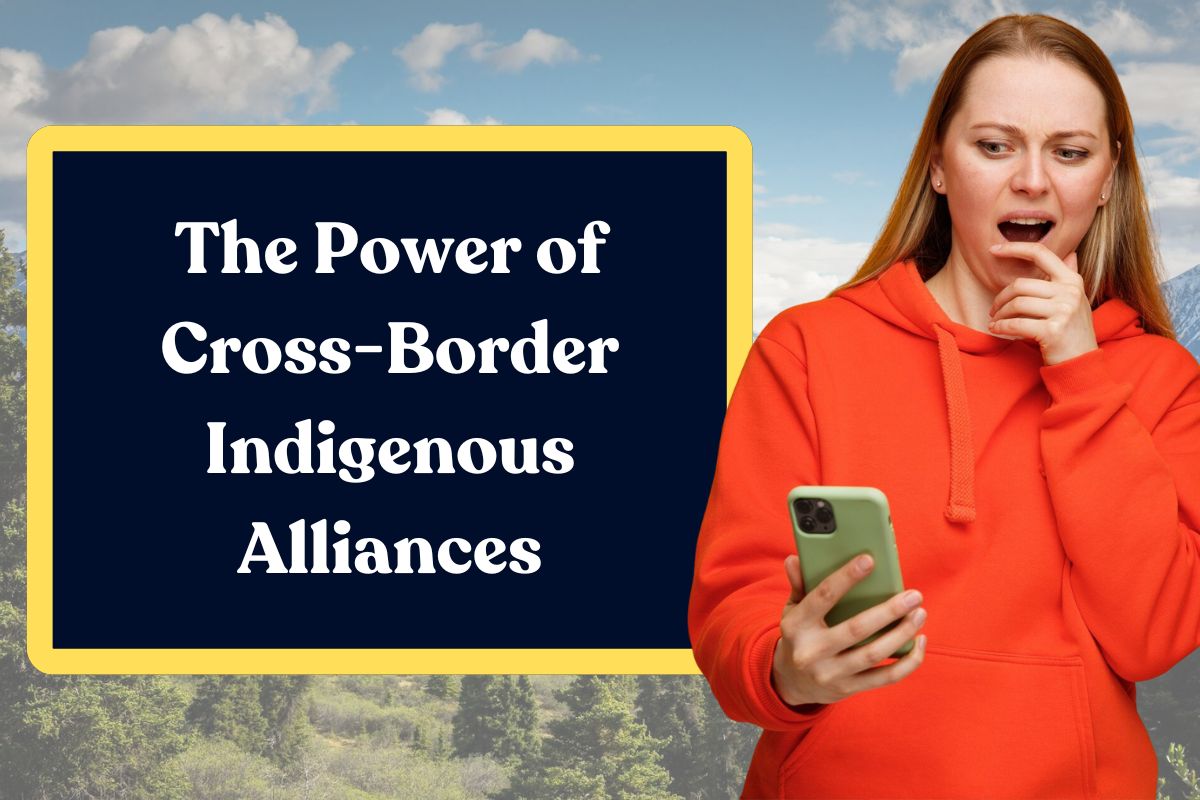Cross-border Indigenous Alliance is a powerful group or cooperation amongst the Indigenous people across international borders. These alliances encourage collaboration for cultural preservation, resource management, and the defense of collective rights.

To address the common challenges and to promote self-determination, these alliances leverage shared languages, histories, and territories, and often at times cut across national boundaries.
These Indigenous communities working together can protect their ancestral territories, advocate for their rights on a global scale, and preserve their cultures.

The Cross-border cooperation among the Indigenous communities fosters the opportunity and need for a shared cultural vision, which leads to the formation of alliances that aim to strengthen their voices collectively and their capacity to address shared concerns.
Deep cultural and historical ties are shared by many Indigenous communities despite living under different national jurisdictions. Along with sharing deep cultural and historical ties, these communities face similar challenges related to land rights, resource extraction, and cultural preservation.

Major Aspects of Cross-Boarder Indigenous Alliances
There are a few major aspects of the Cross-Border Indigenous Alliances that are mentioned below:
Cultural Transmission and Prevention
The Indigenous communities that are separated by state borders ensure the continuity of the cultural heritage, and cross-border alliances make it easier to share traditional knowledge, languages, and cultural practices.

Environmental Protection and Resource Management
The shared ecosystem can be protected by the collaboration of alliances on sustainable resources planning a management strategy, and addressing the environmental threats that affect multiple Indigenous territories.
Collecting Rights Advocacy
Indigenous groups have the capability to strengthen their voices collectively in order to advocate for their rights by uniting across borders. Advocating for land rights, cultural recognition, self-governance, and often the state policies that are creating an impact on their territories.

Addressing Shared Challenges
Common issues such as forced displacement, impacts of climate change, and economic marginalization by developing joint strategies and sharing experiences can be addressed by the alliances.
Strengthening Indigenous Governance
Indigenous governance systems can be enhanced by cross-border cooperation, by facilitating and promoting regional approaches to self-determination, and by the exchange of best practices.
Power of Cross-Border Indigenous Alliances
Cross-Border Indigenous Alliances have certain benefits and powers that are described below:
Strengthening Cultural Identity and Self-Determination
Preserving Traditions and Language:
Through cross-border alliances, Indigenous communities benefit from connecting with their relatives and sharing cultural practices, knowledge, and language, which helps them to preserve and revitalize their culture and heritage.
Promoting Self-Governance:
Indigenous communities can be supported by these alliances by establishing their governance structures, managing their resources, and making decisions that affect their lives.
Reclaiming Ancestral Territories:
Indigenous groups have the right to advocate for the recognition of their traditional territories and rights by working together across borders. This is particularly true for cases where borders have divided their lands.
Addressing Shared Challenges:
Environmental Protection:
Indigenous communities are enabled by cross-border alliances to collaborate on environmental conservation, adaptation strategies for climate change, resource management, and protecting shared resources and ecosystems.
Socioeconomic Development:
Cross-border alliances can support economic development initiatives by pulling resources and expertise that are culturally correct and on point and benefit all the communities that are participating.
Human Rights Advocacy:
Indigenous groups are allowed by the cross-border collaboration to advocate for their human rights at national and international levels, which address issues like discrimination, displacement, and violence.
Examples of Cross-Border Indigenous Alliances:
The Nordic Sami Convention:
Across the borders of Norway, Finland, and Sweden, the Nordic Sami Convention facilitates cooperation between the Sami people within these borders. In this cooperation, the issues related to the language, culture, and traditional way of life are addressed.
Indigenous Peoples along the US-Mexico Border:
Along the border of the US-Mexico, the Yoeme (Yaqui) and other indigenous groups formed alliances to address the issues related to land rights, cultural preservation, and cross-border mobility.
Indigenous Communities in South Africa:
Alliances were formed to address the shared challenges and to advocate for the rights of many Indigenous groups in South Africa, like the Wayuu, Sikuani, and Awa, who live across the national borders.
Some Key Points to Consider:
Respect for Indigenous Governance and Knowledge:
It is important that the cross-border alliances be built on the principles of respect for the Indigenous knowledge systems, decision-making process, and self-governance.
Addressing the Imbalances of Power:
It is quite essential to address and acknowledge potential power imbalances between the different indigenous groups and to make sure that all voices are respected and heard.
Building Trust and Relationships:
For the success of these cross-border alliances, building trust and strong relationships between Indigenous communities and with the external stakeholders is crucial.
Cross-border Indigenous alliances have to face challenges from development pressure, state policies, and internal coordination issues for protecting Indigenous rights and territories.
Challenges Faced by Cross-border Indigenous Alliances
- Border Controls and State Policies
Movements and collaborations can be restricted by the national borders and policies related to them, and require strategic advocacy and navigation.
- Development Pressure
Indigenous rights and territories are often disregarded by extractive industries and development projects, which leads to environmental damage and displacement.
- Internal Coordination and Diversity
Among diverse indigenous groups, maintaining coordination and unity across borders might be complex and requires careful consideration of varied needs and perspectives.
There are a few points of Consideration:
- Right-Based Development: Indigenous rights and territories must be respected by the rights-based approach of the development projects.
- Advocacy and Strategic Navigation: State policies must be navigated effectively, also a need for a cross-border alliance to advocate for their rights
- Internal Unity: For effective collaboration, it is essential to build trust and a strong relationship among the diverse Indigenous groups.
Final Thoughts
These cross-border Indigenous alliances are a very essential and powerful tool for the people of Indigenous alliances to maintain their rights, protect their cultures, and shape their futures. They can overcome difficult challenges, build solidarity, and create a more equitable world for all by working together across borders.






